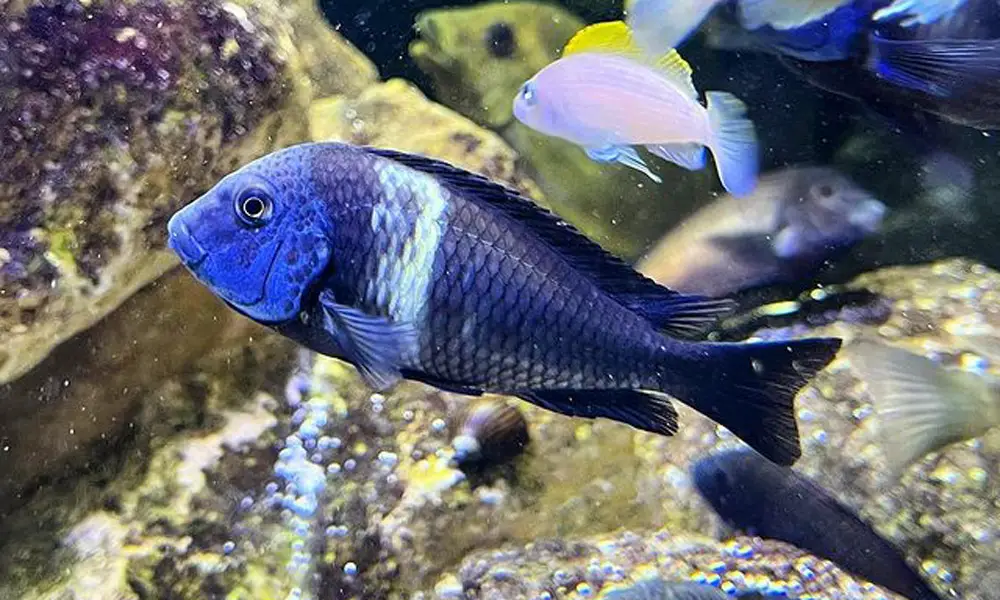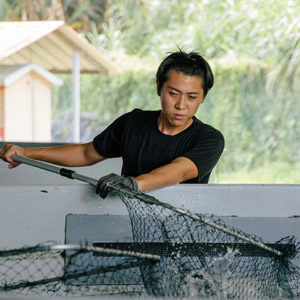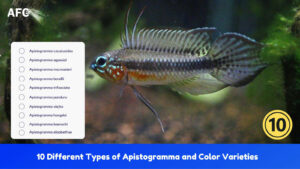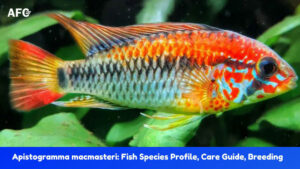Duboisi Cichlid is a rugged fish known for its gorgeous jet-black body adorned with dozens of white spots. Despite their quarrelsome behavior, this species is endearing to many fish keepers.
It no denies that Duboisi Cichlid is hearty and beautiful; keeping them is not a cakewalk, especially for the novice. Therefore, if you think of adding these black beauties to your aquarium, keep scrolling the page to learn about their care guide.
This guide will cover all essential topics regarding this species and teach you about the appropriate tank conditions and water parameters to keep them happy and healthy.
Species Summary
Duboisi Cichlid (Tropheus duboisi), also known as white spotted cichlid, mainly originates from the rocky coastal waters of Northern Lake Tanganyika, Africa. They are restricted to rocky substrates, like rubble or slabs, in the northern portion of the lake. These fish occur to a depth of 30m. You can find three subpopulations in different parts of the lake, namely Maswa, Kariliani Island, and Kigoma.
When it is a juvenile, it is covered in white to bluish polka spots. However, as it matures, the spots start to fade and are replaced with gorgeous bands of color. The adult Duboisi Cichlid looks like a totally different fish, and watching it change from its juvenile to adult coloring is truly a sight to behold.
Tropheus duboisi is classified as Vulnerable by the IUCN Red List of Threatened Species. They first gained popularity in the 1970 and are among the most popular cichlids on the market.
| Scientific Name: | Tropheus duboisi |
| Common Name: | Duboisi Cichlid, White Spotted Cichlid, Blue-Faced Duboisi Cichlid |
| Care Level: | Intermediate |
| Lifespan: | 8 – 10 years |
| Max Size: | 4.8 inches (12cm) |
| Temperature: | 73 – 81°F (23 – 27°C) |
| PH: | 8.0 – 9.5 |
| Water hardness: | 8 – 25°H |
| Diet: | herbivorous |
| Minimum Tank Size: | Single Male: 75 gallons; Two Males: 125 gallons |
| Temperament: | Aggressive |
Appearance

The unique physical appearance and spunky personality make the Duboisi Cichlid an exciting and rewarding addition to your aquarium. Juvenile fish appear jet black with many small white spots. As they age, these sports fade entirely, and their heads develop a bluish tint.
The adult fish will develop a thick yellow vertical band behind the pectoral fin. The width of the band varies between the different subspecies. The head of the mature Tropheus Duboisi is usually bluish, hence the common name of Blue-Faced Duboisi Cichlid.
Males and females have identical coloration, but a few subtle differences between them may help you differentiate them.
Males tend to have a turned-up nose while females boast a greater slope and rounded nose. Males’ coloration is often bold than females, and they grow faster as well. Furthermore, males tend to have a deeper body, whereas women duboisi cichlids are slim and streamlined.
As always, the 100% accurate method to sex Cichlid is by venting. If you’re not experienced in this process, we recommend taking your fish to the nearest aquarium store or vet.
Tropheus Duboisi (Duboisi Cichlid) Size
The maximum size of Tropheus Duboisi is about 4.8 inches (12cm). Males grow slightly larger than females. The Duboisi Cichlid can grow up to 5 inches in length in the wild, but they grow up to 4.7″ in captivity.
Also, adult males grow at a faster rate and display their colors sooner. While they can reach up to 4.8 to 5 inches in an aquarium environment, the approximate purchase size of Duboisi Cichlids is 1.5 to 2.5 inches.
Being a popular Tanganyika cichlid, to help your Duboisi Cichlid grow to its potential, you should add iodized table salt to the water as they need iodine for the thyroid to function properly. The Cichlid Lake Salt is the best choice for this purpose.
- Non acidic. Manufactured in United States
- Will not impact Ph
- Will not impact skimmers
Author notes: Be careful not to add too much as it may cause bloat.
Lifespan
The average life expectancy of Duboisi Cichlid is five years, but they can survive up to 8- 10 years if kept in good tank conditions and fed with a well-balanced diet.
The lifespan of these species depends on the quality of care. Like other fish specimens, they are also prone to health concerns, especially known to “bloat” on hobbyists. Hence, it is advised to take optimal care of them and keep them in your tank for long.
Like any other captive-bred species, genetics can influence the lifespan of Duboisi Cichlid. If your fish are bred and raised by a professional breeder, they are more likely to have a longer lifespan.
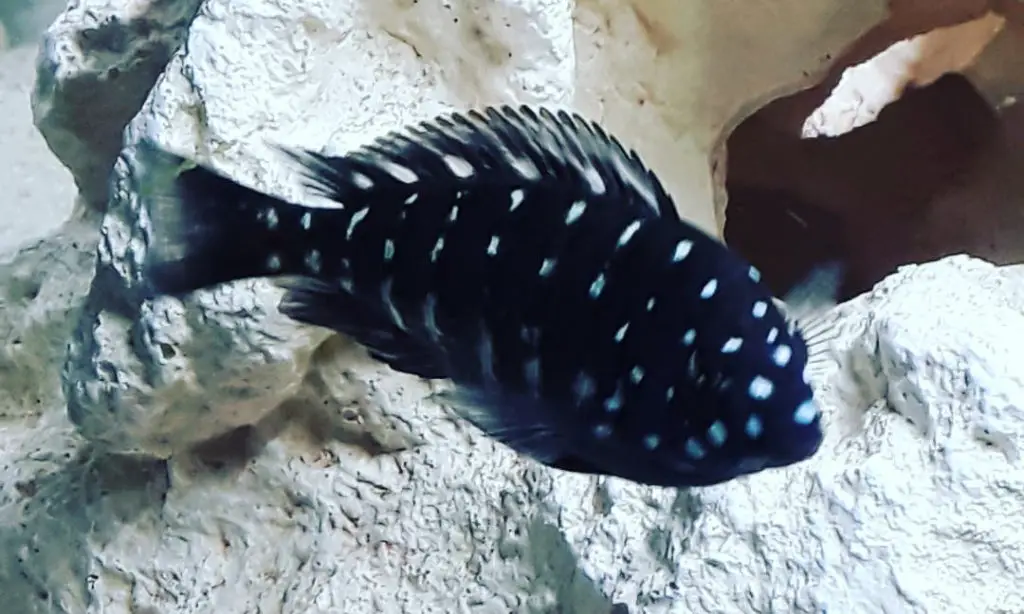
Care and Tank Setup
Before bringing Tropheus Duboisi home, it is essential to set up their tank properly. These fish are native to Lake Tanganyika, which is one of the oldest freshwater lakes in the world.
It’s also worth noting that taking care of these species is not everyone’s cup of tea. Unlike other cichlids, they are highly aggressive fish and very susceptible to African Bloat (Malawi Bloat), making them a challenging species to keep for beginners.
Hence, it is essential to maintain the appropriate tank conditions and water parameters to keep their mood right. Here’re some guidelines to follow when adding Duboisi Cichlid to your aquarium.
Tank Size
These fish are pretty active and will prefer swimming around in the tank; keeping their aggression and activeness in mind, never dare to put them in a small aquarium.
A minimum 75 gallons tank (48″ x 18″ x 21″) is recommended for a large group of 12 or more with only one adult male. If you plan on having more than one male in your tank, you need to invest in a tank that’s at least 125 gallons (72″ x 18″ x 21″).
Due to their aggressive nature and individual behaviors, it is best to keep these species in an ample space where they can swim and get enough hiding places.
Water Parameters
Since these cichlids are active swimmers, they need significant water movement and a sturdy filtration system. They don’t do well with unstable parameters or frequent water changes. As for water changes, conduct 15% twice a week or 30% once a week to maintain water with small, regular changes.
Tropheus duboisi needs hard alkaline water, but make sure that the salinity should be less than 10% of a regular saltwater tank. Also, keep them in a highly oxygen-rich environment as well as the water’s pH and nitrate levels are maintained optimally.
Strictly follow the below-mentioned water parameters to make them feel comfortable.
- pH: 8.0 – 9.5
- Water Temperature: 73 – 81°F (23 – 27°C)
- Hardness: 8 – 25°H
- Ammonia: 0ppm
- Nitrite: 0ppm
- Nitrate: <30ppm
Decor (Plants and Substrate)
Incorporate plenty of rocks and African driftwood, so Duboisi Cichlids can build caves and get some suitable hiding spaces. Fishkeepers should add a sandy bottom of aragonite to maintain the necessary pH and alkalinity. A sandy substrate will work as well.
Live plants are not necessary for the Tropheus Duboisi aquarium, and they can be harmful due to their aggressive nature. However, you may add well-rooted artificial plants if you want the aesthetic look of your tank and help the fry have a higher survival rate.
Air stones or aerating decorations to keep your tank oxygenated are appreciated. Avoid overstocking, which may result in stress.
Food & Diet
Duboisi cichlids are known to be omnivorous, but their diet may consist of herbivorous foods. In the wild habitat, they are known as aufwuchs feeders. They primarily feed on stingy and tough algae stuck on rocks and the microorganism it upholds.
You can serve them spirulina flakes and pellet foods in an aquarium environment. Fish keepers can also add romaine or spinach to their diet and provide this nutrition-rich food at least once a day. Apart from the vegetable matter, add flake food, fiber-based diets, and moderate protein to their diet.
Exercise some caution with protein-rich food; only supplement with small feeds of live and frozen shrimps and worms. Mammal meats like beef heart and mosquito larvae should be avoided. Also, never overfeed them as it may contribute to bloat.
- New Life Spectrum is made from quality natural ingredients
- Extreme Color enhancement and vitality in your fish
- Made in the USA
Duboisi Cichlid Tank Mates
Despite their potential to be aggressive fish, the best practice is to house Duboisi Cichlid in a large group of at least 11 females with one male in a species-specific tank. They are not schooling fish in nature, but several females help reduce the aggression level of the male.
Some sellers say you can house them with a small group of 5 or 6 females with one male, but we disagree. These fish do not do well in small groups, and a single male will harass any females until they are either dead or too exhausted to bloated.
While the exceptions exist, we have seen few aquarists who succeeded with a small group of 6 or more, even a pair of living peacefully together.
Never add a new fish to an established tank, as it may cause a lot of unwanted stress. Sometimes, this will result in the death of new fish.
Although Tropheus Duboisi are considered to be less aggressive than their close relatives, such as , they tend to be toward conspecifics.
Here are some possible Tropheus moorii Tank Mates:
- Marlieri Cichlid (Julidochromis Marlieri)
- Cyprichromis leptosoma (Sardine Cichlid)
- Synodontis sp. (Cuckoo Catfish | Dwarf Petricola | Lace catfish)
- Tropheus moorii (Blunthead Cichlid)
- Brown Julie (Julidochromis dickfeldi )
- Convict Julie (Julidochromis regani)
- Golden Julie (Julidochromis ornatus)
- Striped Goby Cichlid (Eretmodus cyanostictus)
- Spotfin Goby Cichlid (Tanganicodus irsacae)
Final Thoughts
Duboisi Cichlids (Tropheus Duboisi) can make an interesting addition to your freshwater fish tank, but they are not sweet by nature. These cichlids need excellent maintenance and appropriate tank conditions.
With proper maintenance and a healthy diet, Tropheus duboisi can thrive and bring life to your aquarium. So go ahead and add these energetic little fish to your tank today.
If you have any questions or tips about Duboisi Cichlids care that you’d like us to add to the guide, please leave us a comment below.
And as always, happy fishkeeping!
